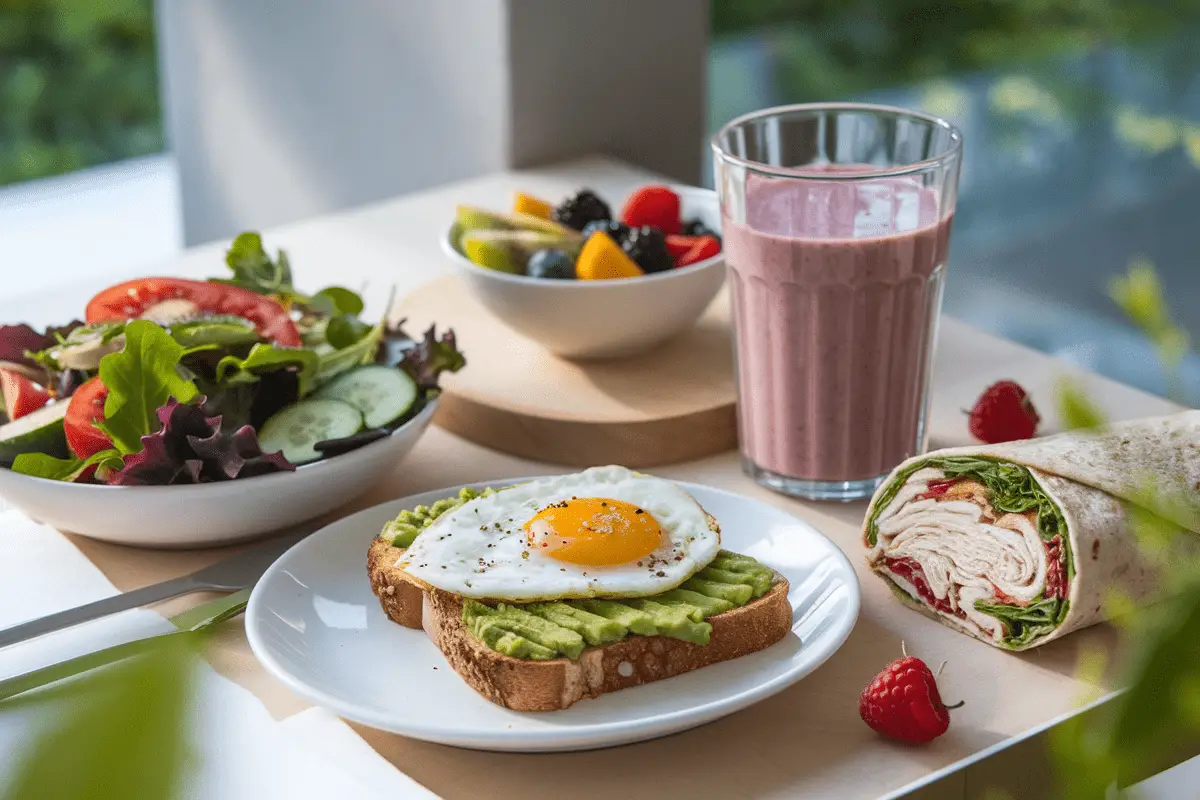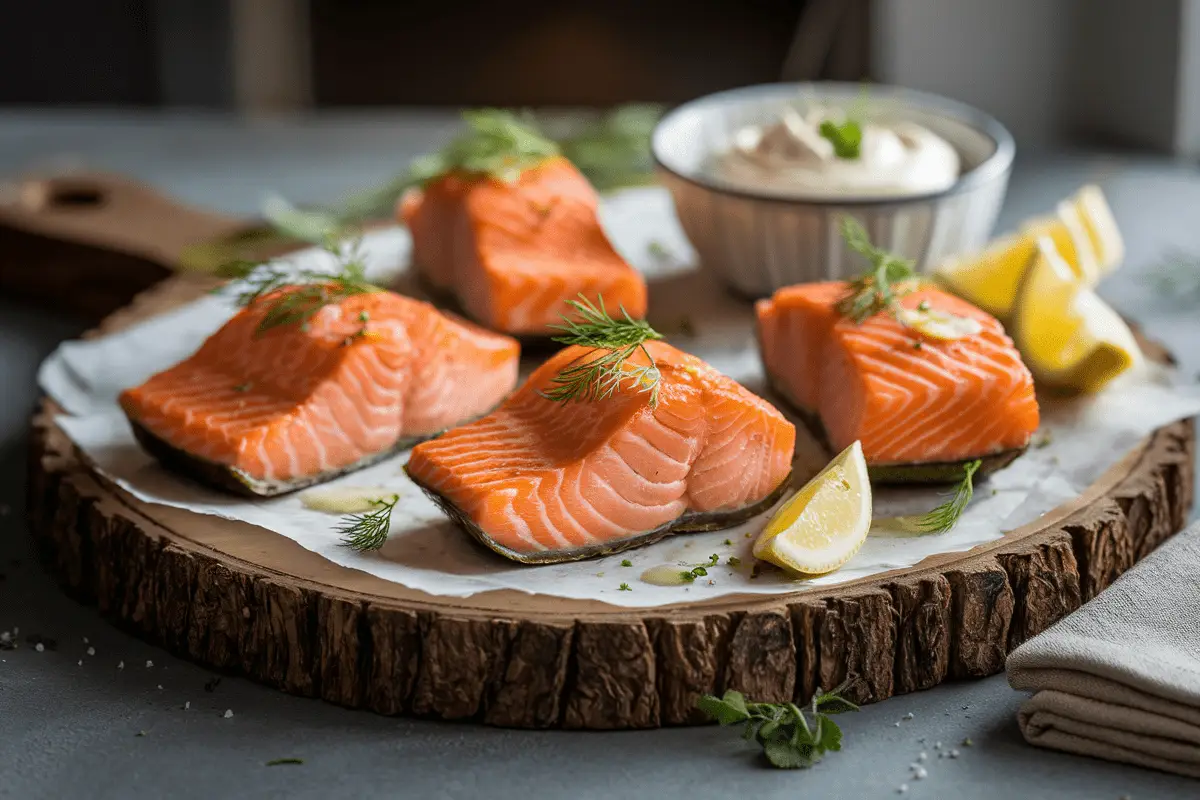The noodle pudding recipe, also known as Lokshen Kugel, is a beloved dish that combines tradition with modern comfort food. With its roots in Eastern European Jewish cuisine, this delightful blend of sweet noodles, creamy custard, and optional raisins has earned its place as a favorite at holiday tables and gatherings. Whether served as a dessert or a side dish, perfecting this classic recipe is a truly rewarding experience.
- The beauty of noodle pudding lies in its versatility. It can be prepared in sweet or savory variations, making it a crowd-pleaser for all tastes.
- The secret to a great recipe lies in achieving the perfect balance of flavors and textures: crispy edges, a tender noodle interior, and a creamy custard base.
For additional dessert inspiration, check out this recipe for sugared cranberries, which pairs wonderfully with a kugel meal. Or, if you’re looking for ideas for a complete meal, these steak and pasta recipes offer complementary options to serve alongside noodle pudding.
Prepare to embark on a journey to create the most satisfying noodle pudding that will leave everyone asking for seconds!
What is Noodle Pudding?
Noodle pudding, also known as Lokshen Kugel, is a traditional baked dish with roots in Jewish cuisine. It is a delightful mixture of egg noodles, a creamy custard base, and optional additions like raisins or cinnamon, making it both versatile and comforting.
- Historically, noodle pudding was a staple in Eastern European Jewish households, often enjoyed during festive occasions. Its name, “kugel,” means ball or round in German, which reflects its original round shape.
- This dish can be prepared in two main variations:
- Sweet noodle pudding, often featuring sugar, raisins, and vanilla for a dessert-like experience.
- Savory noodle pudding, incorporating onions, garlic, and herbs for a hearty side dish.
The texture of noodle pudding is one of its most defining features. The top is usually baked to a golden, crispy finish, while the inside remains soft, tender, and creamy. Whether it’s served warm or cold, this dish is always a comforting addition to any meal.
For a delicious twist, consider pairing noodle pudding with these cinnamon toast cereal recipes to create a sweet brunch spread. Or, for a savory alternative, you could explore this ultimate guide to pizza rustica recipes as an accompanying dish.
Noodle pudding is not just a recipe—it’s a culinary tradition passed down through generations, bringing families together over its rich flavors and heartwarming simplicity.
Ingredients Overview
Crafting the perfect noodle pudding recipe begins with choosing high-quality, flavorful ingredients. Each element plays a vital role in striking the ideal balance of sweetness, creaminess, and texture. Here’s a detailed look at the essential components:
- Wide Egg Noodles: The base of the dish, these noodles are soft yet sturdy, perfect for holding the custard mixture. Opt for fresh or dried varieties depending on availability.
- Eggs: A key binding ingredient, eggs provide the structure for the creamy custard.
- Sugar: Adds a touch of sweetness, balancing the richness of the other ingredients.
- Sour Cream: Contributes a tangy flavor and silky texture to the pudding.
- Cottage Cheese: Adds creaminess and a subtle savory undertone to complement the sweetness.
- Butter: Ensures a rich and indulgent finish while helping to achieve crispy edges.
- Raisins (optional): For those who love a fruity touch, raisins add sweet bursts throughout the dish.
- Cinnamon or Nutmeg (optional): A sprinkle of these spices adds warmth and enhances the flavor.
For those looking for a unique variation, try combining the noodles with elements inspired by this sourdough cinnamon rolls recipe. The touch of spice can elevate the dish’s sweet flavor profile.
If you prefer a savory twist, incorporating ideas from this chicken and dressing recipe can transform the pudding into a hearty side dish.
These versatile ingredients make noodle pudding a dish that’s easy to customize. Whether you stick with tradition or experiment with new flavors, the result will always be a crowd-pleaser!
Step-by-Step Guide to Making Noodle Pudding
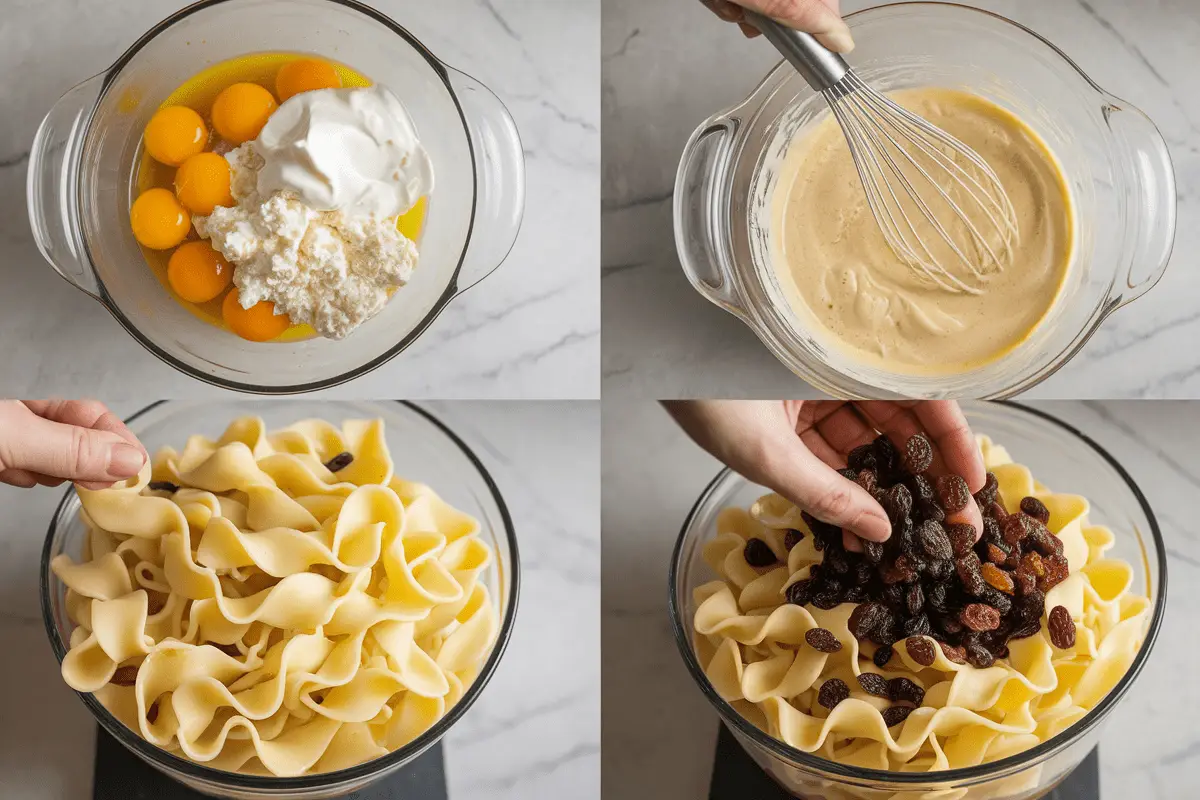
Making the perfect noodle pudding is a rewarding process that involves simple yet essential steps to achieve a creamy and delicious result. Here’s a step-by-step guide:
S1: Prepare the Ingredients
- Cook the wide egg noodles in salted boiling water until al dente. Drain and let cool slightly.
- While the noodles cool, gather and measure the other ingredients, such as eggs, sour cream, cottage cheese, sugar, and butter.
- If you enjoy a fruity touch, soak raisins in warm water for a few minutes to plump them up.
For an added twist, consider sprinkling the dish with ideas inspired by this cinnamon toast cereal recipe to create an additional layer of texture and sweetness.
S2: Create the Custard Mixture
- In a large mixing bowl, whisk together the eggs, sugar, sour cream, cottage cheese, and a pinch of cinnamon or nutmeg (optional).
- Stir in melted butter and ensure the mixture is smooth and creamy.
You can explore additional flavor combinations by borrowing elements from this fruit smoothie bowl recipe, such as using fresh fruit toppings for a creative variation.
S3: Combine and Assemble
- Gently fold the cooked noodles into the custard mixture, ensuring they are fully coated. Add raisins if desired.
- Transfer the mixture into a greased baking dish, spreading it out evenly. A pastel blue dish, similar to those used in this churro cheesecake recipe, can enhance the presentation.
S4: Bake the Pudding
- Preheat the oven to 350°F (175°C).
- Bake for 45-60 minutes, or until the top is golden brown and the custard has set. Rotate the dish halfway through for even cooking.
S5: Cool and Serve
- Allow the pudding to cool slightly before slicing to maintain its structure.
- Serve warm or chilled, depending on preference. For a complementary side, try pairing it with dishes like this easy chicken and shrimp fried rice for a balanced meal.
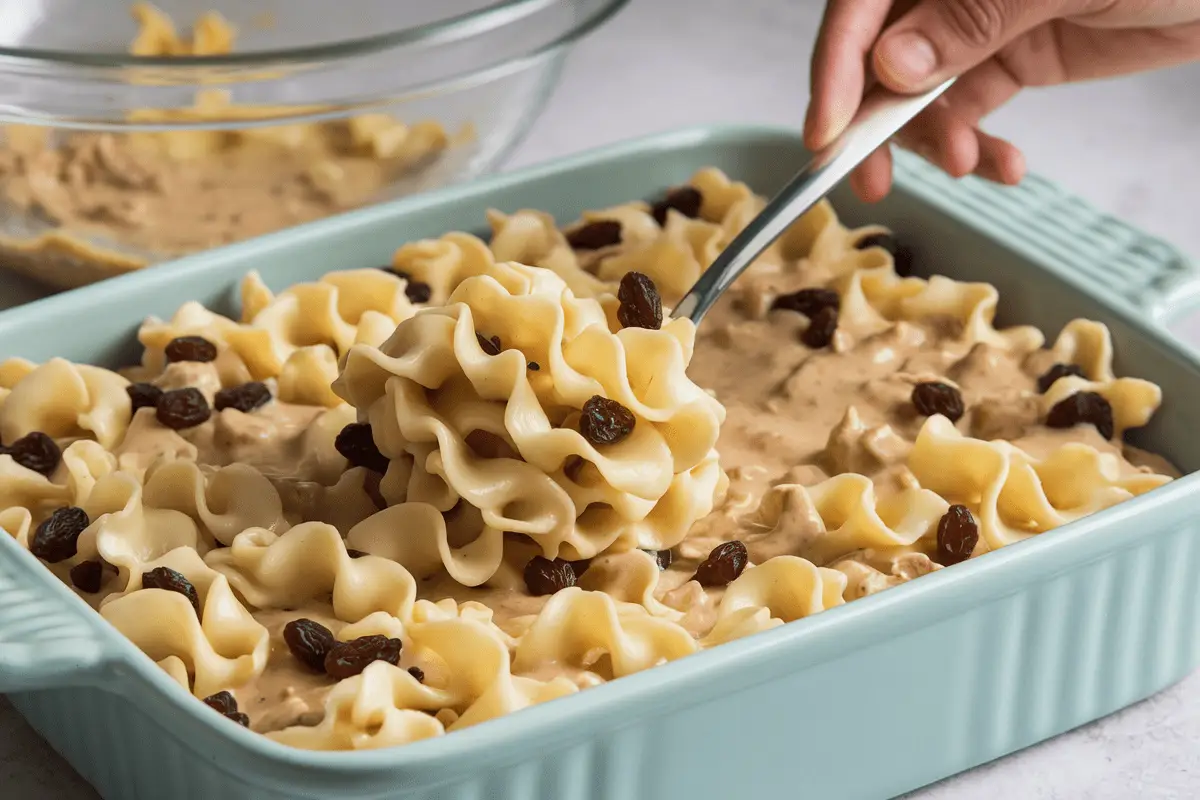
This step-by-step process ensures your noodle pudding turns out perfect every time, with the creamy interior and crispy edges that make it a beloved dish. Feel free to customize it to suit your taste or occasion!
Top Variations of Noodle Pudding
Noodle pudding, or Lokshen Kugel, is a versatile dish that lends itself to a wide range of creative variations. Whether you prefer the traditional sweet version or an unexpected savory twist, there’s a style for every taste. Below are some of the top variations to inspire your next creation:
1. Classic Sweet Noodle Pudding
- This version is the hallmark of Jewish holidays and includes ingredients like raisins, sugar, and cinnamon. The creamy custard pairs perfectly with the soft noodles, creating a dessert-like treat.
- Add a hint of fruitiness by borrowing flavors from this fruit smoothie bowl recipe, such as fresh berries or a drizzle of honey on top for extra sweetness.
2. Savory Noodle Pudding
- For those who prefer savory dishes, omit the sugar and add onions, garlic, and fresh herbs. Sprinkle a layer of cheese on top for a rich, golden crust.
- This variation pairs wonderfully with hearty meals, like the recipes featured in this chicken and dressing guide.
3. Modern Chocolate Noodle Pudding
- Elevate the sweet version by mixing in mini chocolate chips and a touch of vanilla extract. This twist transforms noodle pudding into a decadent dessert, similar in appeal to this churro cheesecake recipe.
4. Apple Cinnamon Noodle Pudding
- Add thinly sliced apples to the custard mixture, along with extra cinnamon and nutmeg. The apples bring a seasonal warmth, making this perfect for fall gatherings.
- Complement this flavor by pairing it with a refreshing dessert like these cinnamon toast cereal recipes.
5. Gluten-Free Noodle Pudding
- Replace traditional egg noodles with gluten-free alternatives. This version ensures everyone at the table can enjoy the dish without compromise.
These variations allow you to tailor your noodle pudding to any occasion, whether you’re serving it as a side dish or a sweet centerpiece. Experiment and find your favorite version to share with family and friends!
Tips and Tricks for Perfect Noodle Pudding
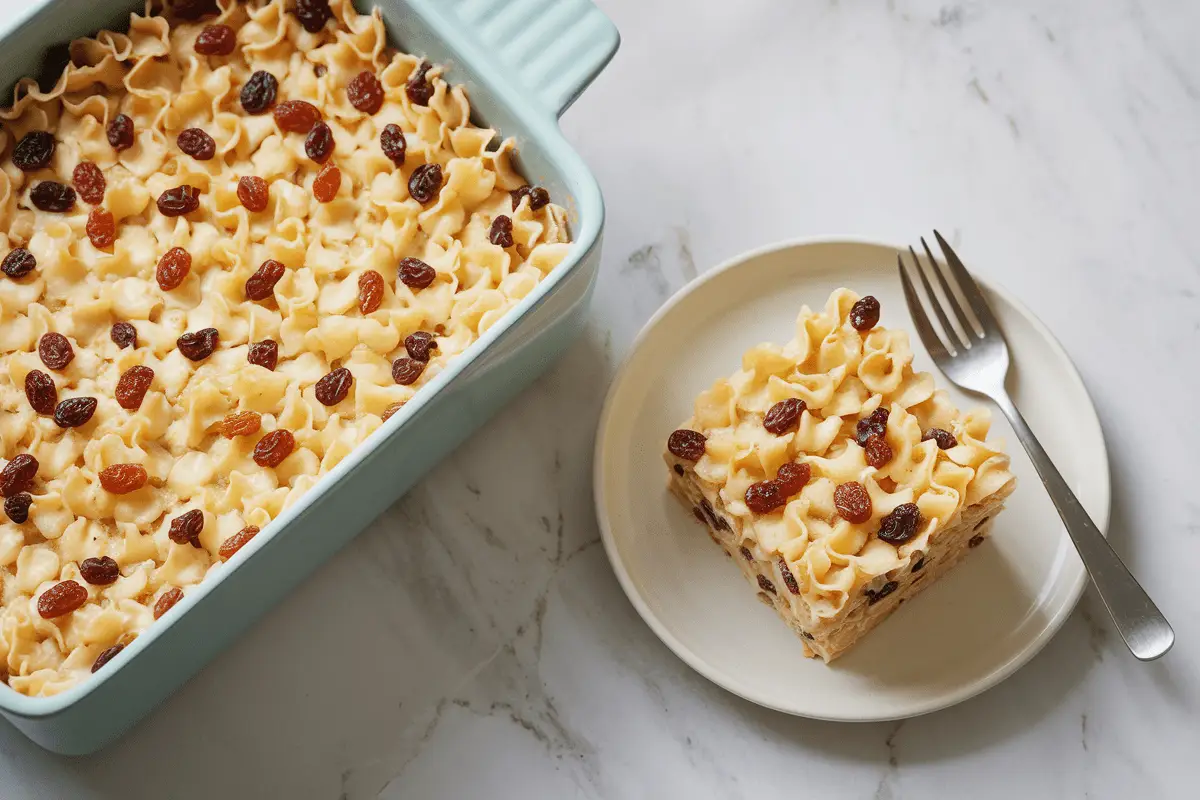
Mastering the perfect noodle pudding recipe takes a bit of attention to detail and some essential techniques. Whether you’re trying it for the first time or refining your approach, these tips will help you achieve delicious results every time.
1. Balance the Custard and Noodles
- Ensure your custard is rich and creamy by using the right ratio of eggs, sour cream, and cottage cheese. Too little custard can leave the pudding dry, while too much can make it soggy.
2. Use the Right Type of Noodles
- Opt for wide egg noodles as they hold the custard better and provide a soft, tender texture. For a gluten-free option, explore alternatives inspired by this gluten-free granola bar recipe.
3. Add Flavor Enhancements
- Incorporate cinnamon, nutmeg, or vanilla extract into the custard for added depth. If you’re creating a savory variation, herbs like parsley or chives can elevate the dish.
4. Achieve the Perfect Bake
- Bake at 350°F (175°C) and check for a golden, crispy top. Rotate the dish halfway through to ensure even cooking.
5. Customize Toppings
- Sprinkle crushed cornflakes or breadcrumbs on top for added crunch. For a sweet version, borrow ideas from this cinnamon toast cereal recipe to give the pudding a unique twist.
6. Let It Rest Before Serving
- Allow the pudding to cool slightly after baking. This helps it firm up and makes slicing easier.
By following these tips, you’ll create a noodle pudding that is perfectly creamy inside with a crispy, flavorful top. It’s a guaranteed crowd-pleaser for any occasion!
Healthier Alternatives to Traditional Recipes
For those looking to enjoy noodle pudding while maintaining a healthier lifestyle, there are plenty of creative substitutions and adjustments you can make without sacrificing flavor. Here are some great ways to lighten up this classic dish:
1. Swap for Whole-Grain Noodles
- Replace traditional wide egg noodles with whole-grain or gluten-free alternatives to add more fiber and reduce refined carbs. This adjustment aligns with recipes like the healthy cheesecake recipe that focus on nutritious ingredients.
2. Use Low-Fat Dairy
- Opt for low-fat sour cream, cottage cheese, and milk instead of full-fat varieties. This change reduces calories while retaining the creamy texture.
3. Cut Back on Sugar
- Use natural sweeteners like honey, maple syrup, or stevia instead of white sugar. You can also take inspiration from this fruit smoothie bowl recipe by incorporating fresh fruit for natural sweetness.
4. Add More Protein
- Incorporate Greek yogurt or protein-enriched cottage cheese for a boost of nutrition. These ingredients also make the custard more filling.
5. Enhance the Toppings
- Sprinkle crushed nuts, seeds, or a touch of granola instead of sugary toppings. Borrow ideas from this nut-free granola bar recipe for healthier alternatives.
6. Focus on Portion Control
- Serve the pudding in smaller ramekins or individual portions to maintain balance while enjoying your favorite dish.
By making these simple substitutions, you can create a healthier noodle pudding that is just as satisfying as the traditional version. Whether you’re cutting calories or adding nutrients, these tweaks ensure you can indulge guilt-free!
FAQs About Noodle Pudding
Here are answers to some of the most frequently asked questions about noodle pudding to help you perfect this timeless dish:
1. Can noodle pudding be made ahead of time?
- Yes, noodle pudding is great for meal prep. You can assemble it a day in advance, cover it tightly, and store it in the refrigerator. Before baking, let it sit at room temperature for about 20 minutes.
For more make-ahead meal inspiration, check out this chicken and dressing recipe that’s equally convenient for planning ahead.
2. How do you store and reheat noodle pudding?
- Store leftover pudding in an airtight container in the refrigerator for up to 3-4 days. Reheat individual servings in the microwave or warm the entire dish in the oven at 300°F (150°C) until heated through.
3. Is noodle pudding served as a dessert or side dish?
- It depends on the recipe! Sweet variations with sugar, cinnamon, and raisins are typically served as desserts, while savory versions with onions and herbs make an excellent side dish for main courses.
Consider pairing a savory noodle pudding with a hearty entrée, like those in this beef back ribs recipe for a complete meal.
4. What are the best noodles for noodle pudding?
- Wide egg noodles are the classic choice because they hold up well during baking and absorb the custard mixture beautifully. For a gluten-free version, opt for rice noodles or quinoa pasta.
5. Can I freeze noodle pudding?
- Yes, you can freeze noodle pudding! Bake it first, let it cool completely, and wrap it tightly with plastic wrap and foil. It can be frozen for up to 2 months. Thaw in the refrigerator before reheating.
These answers ensure that your noodle pudding turns out perfectly every time, no matter the occasion. Explore these tips and variations to make the most of this versatile dish!
Serving Suggestions and Pairings
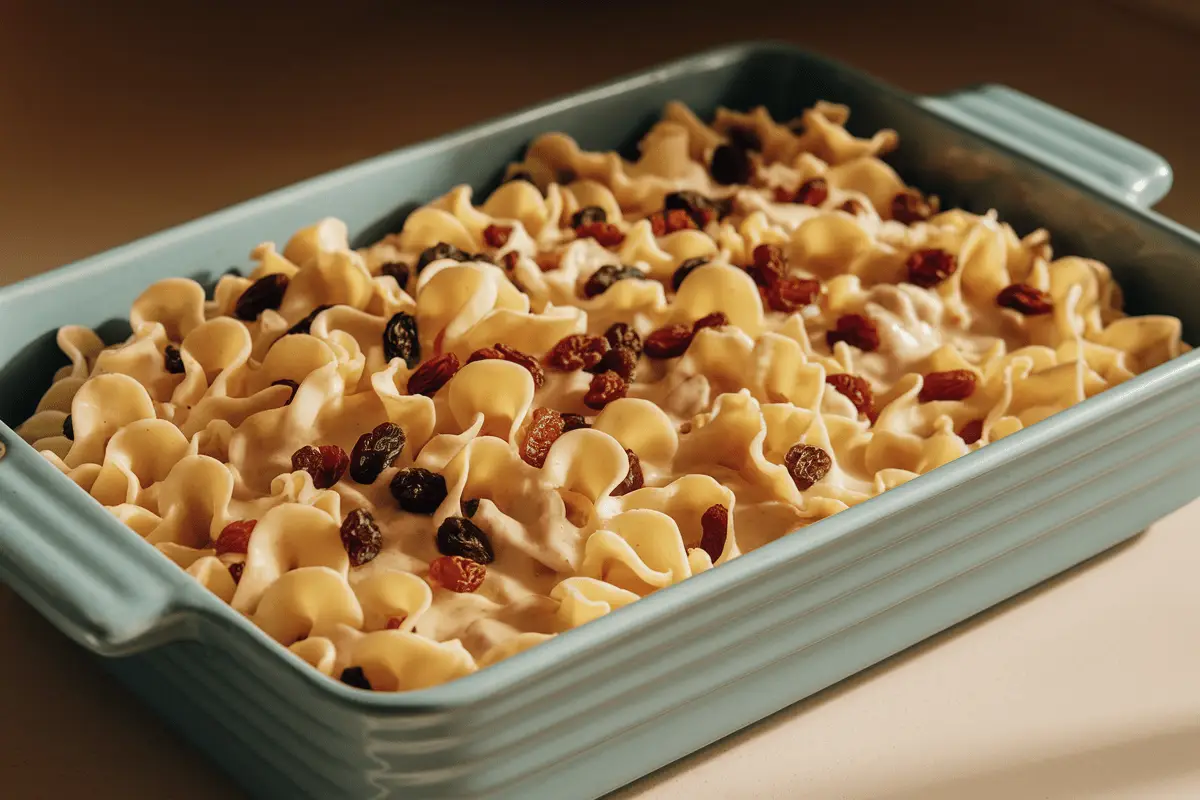
A noodle pudding recipe is a versatile dish that fits seamlessly into a variety of occasions, from festive dinners to casual brunches. Explore these serving and pairing ideas to elevate your meal experience and make the most of this timeless favorite.
1. Sweet Noodle Pudding
- Serve as a warm dessert topped with a dollop of whipped cream or a sprinkle of powdered sugar. For a seasonal twist, try drizzling it with a fruit compote inspired by this fruit smoothie bowl recipe.
- Pair with hot beverages like chai tea or coffee for a cozy finish to any meal.
2. Savory Noodle Pudding
- Use as a side dish alongside roasted meats or poultry. A savory variation complements hearty recipes, like the flavors in this beef back ribs recipe.
- Add a green salad with a tangy vinaigrette to balance the richness of the pudding.
3. Brunch Delight
- Feature noodle pudding as part of a brunch spread. Pair it with lighter fare like this easy chicken and shrimp fried rice for a delightful mix of sweet and savory options.
With its rich flavors and creamy texture, noodle pudding can be tailored to fit any meal or celebration. Experiment with these pairings to discover your favorite combinations!
Conclusion
A noodle pudding recipe, also known as Lokshen Kugel, is more than just a dish—it’s a timeless classic that brings comfort, tradition, and versatility to your table. Whether you prefer a sweet version with raisins and cinnamon or a savory twist with herbs and cheese, this recipe is always a guaranteed crowd-pleaser.
- Pair it with dishes like this beef back ribs recipe for a hearty meal.
- For dessert lovers, combine it with flavors inspired by this cinnamon toast cereal recipe.
Explore these customizations and pairings to make noodle pudding uniquely yours. Its rich history and adaptability will make it a cherished staple in your recipe collection. Happy cooking!
Recommended External Links
- Anchor Text: “Understanding the History of Kugel”
Link: Jewish Food Society - Anchor Text: “Tips for Baking Perfect Casseroles”
Link: Taste of Home - Anchor Text: “Nutritional Information for Noodle-Based Dishes”
Link: Nutrition Data

